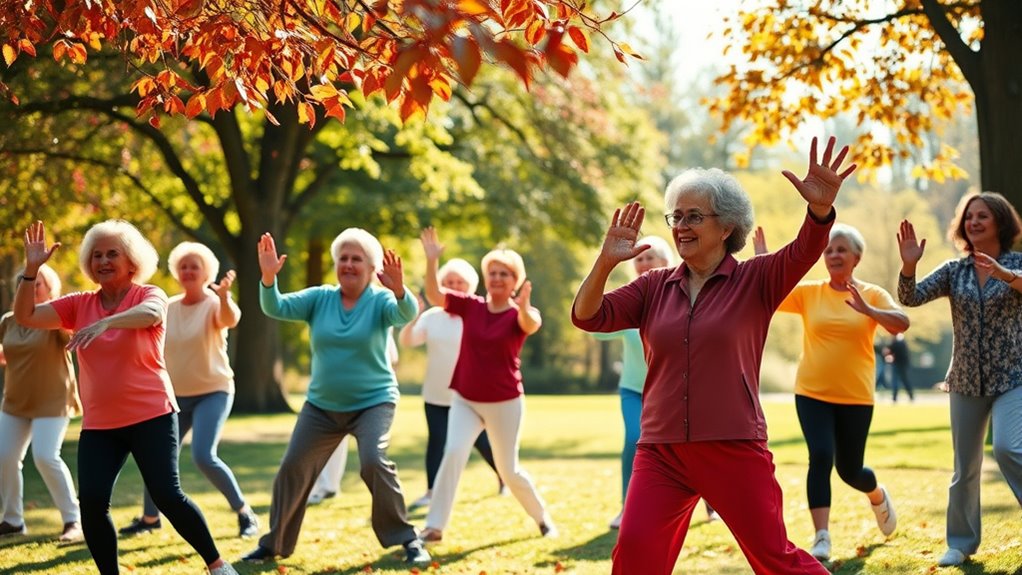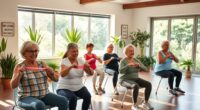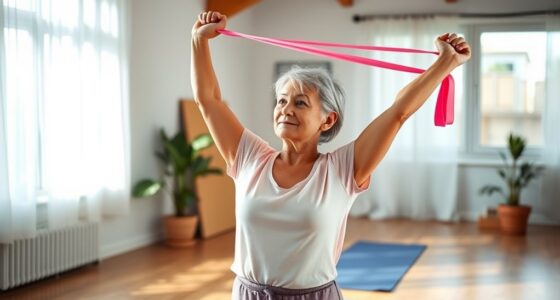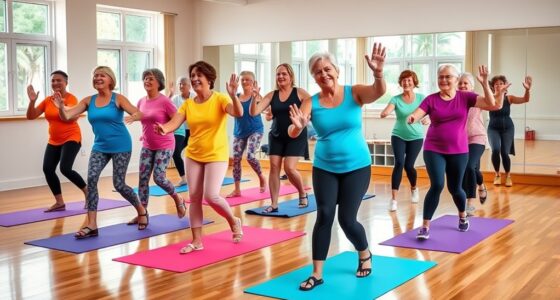Exercise can truly revolutionize your routine as a senior by boosting your energy, enhancing your mood, and reducing the risk of chronic diseases. Aim for at least 150 minutes of moderate aerobic activity each week, along with strength training and balance exercises. Low-impact options like swimming and yoga can keep you engaged and safe, and joining group activities provides motivation and social connections. Discover how simple adjustments can further enhance your fitness journey.
Key Takeaways
- Incorporate low-impact cardio activities like swimming or cycling to boost energy and enhance cardiovascular health without risking injury.
- Engage in strength training exercises, such as chair squats and wall push-ups, to maintain muscle mass and reduce fall risk.
- Include balance exercises, like tai chi, at least three times a week to improve stability and prevent falls.
- Join social exercise classes to foster motivation, create accountability, and enhance mental well-being through social interaction.
- Establish a routine by setting realistic fitness goals, varying exercises, and tracking progress to maintain interest and commitment.
Health Benefits of Exercise for Seniors
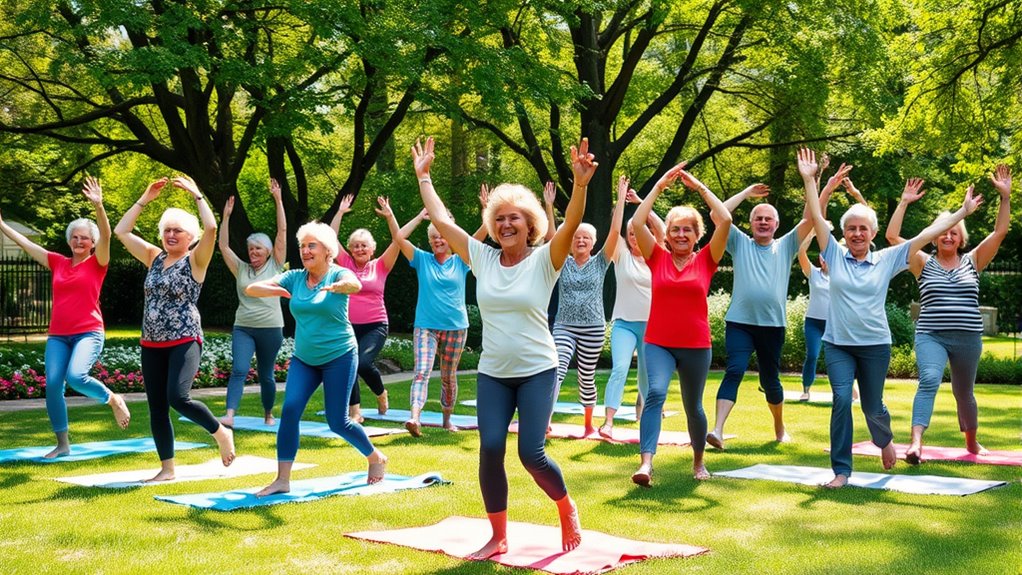
When you engage in regular exercise, you’ll find that it greatly boosts your energy levels and combats fatigue.
The health benefits of exercise for seniors extend beyond just feeling more energetic; it can also reduce the risk of chronic diseases like heart disease, diabetes, and osteoporosis. By participating in physical activity, you not only improve balance but also promote better overall health outcomes, leading to enhanced investment in personal health. Engaging in exercise also contributes to higher energy levels, allowing seniors to stay active and engaged in their daily activities. Additionally, regular physical activity can help mitigate financial considerations associated with healthcare costs due to chronic illnesses. Regular physical activity can also improve joint health, which is essential for maintaining mobility and independence.
Regular exercise helps alleviate joint pain, enhancing mobility and daily functioning, making your life more enjoyable. Additionally, staying active improves cognitive function, as studies show a nearly 50% reduction in the risk of Alzheimer’s and dementia among those who exercise.
Prioritizing exercise can lead to improved sleep quality, allowing you to wake up rejuvenated and ready to take on the day. Moreover, engaging in physical activity can align with vibrational energy, enhancing your overall wellness and manifesting a healthier lifestyle.
Recommended Exercise Guidelines
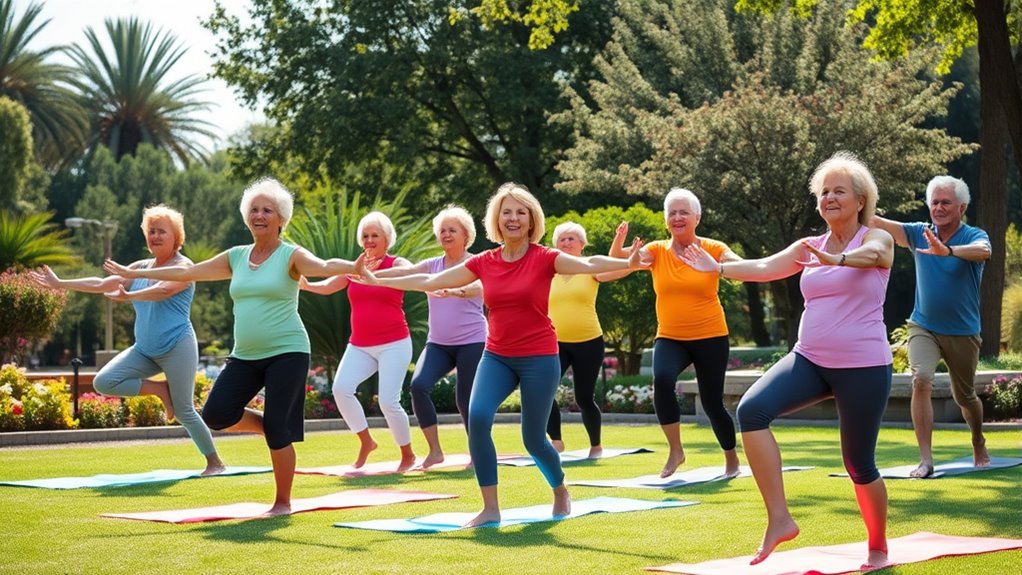
Regular exercise is essential for seniors looking to maintain their health and well-being. The recommended exercise guidelines suggest aiming for at least 150 minutes of moderate-intensity aerobic activity each week or 75 minutes of vigorous-intensity activity.
You should also include muscle-strengthening activities on at least two days per week to preserve muscle mass and bone density. Don’t forget to incorporate balance exercises, like tai chi or standing on one leg, at least three times weekly to help reduce the risk of falls. Additionally, maintaining a cooperative co-parenting plan can ensure emotional well-being during transitions that may arise in later life.
Best Types of Exercises for Seniors

When it comes to staying active, low-impact cardio options like swimming and cycling are fantastic for your heart without stressing your joints. Additionally, engaging in music-making can foster creativity and self-expression, contributing to overall emotional well-being. You’ll also want to focus on strength and flexibility training, which helps maintain muscle and improve balance. This is particularly important for seniors, as cognitive impairment can affect physical activity levels. Regular exercise can also help mitigate common health concerns as you age. Together, these exercises can keep you fit, healthy, and independent as you age. Additionally, incorporating low-impact exercises can significantly enhance overall mobility and reduce the risk of injury. Regular routine checkups with healthcare professionals can also ensure that your exercise regimen is safe and effective as you age.
Low-Impact Cardio Options
As you explore exercise options that suit your lifestyle, low-impact cardio exercises stand out as an excellent choice for seniors. These activities, like swimming, cycling, and water aerobics, help improve cardiovascular health while protecting your joints. Incorporating regular exercise can also enhance air quality in your environment, especially if you use an air purifier with HEPA filtration to capture allergens and pollutants. Regular physical activity can also lead to increased energy efficiency similar to the benefits provided by heat pumps. Additionally, maintaining good indoor air quality through proper air purifier maintenance can further enhance your overall well-being during workouts. Engaging in outdoor activities such as portable camping toilets can also offer convenient options for those who love to exercise in nature.
By incorporating regular exercise, you can enjoy benefits that enhance your quality of life.
- Experience better sleep and reduced joint pain
- Boost your energy levels and overall wellness
- Foster social connections through activities like dancing or walking
The CDC recommends at least 150 minutes of moderate-intensity aerobic activity weekly, making it easy to stay active with enjoyable low-impact forms of exercise. Additionally, engaging in regular physical activity can lead to long-term energy savings that contribute to lower utility bills, similar to the benefits of energy-efficient heat pumps.
Embrace these options to maintain your health and enjoy life to the fullest!
Strength and Flexibility Training
To maintain your strength and flexibility as you age, incorporating targeted exercises into your routine is essential. Strength training is vital for you, as it helps maintain muscle mass and bone density, reducing the risk of falls. Start with bodyweight exercises like wall push-ups and chair squats, which can be easily modified for your fitness level. Engaging in interactive learning toys during your workouts can provide additional motivation and enhance your focus. Additionally, incorporating balance bikes into your routine can further develop coordination and balance, crucial for preventing falls. Regular decluttering sessions can also help create a more organized and motivating workout environment. Including a protein-rich breakfast option like Egg Rollup and Dumpling Sauce can provide you with the energy needed to tackle your exercise routine effectively.
Flexibility training, including daily stretching, enhances your range of motion and mobility, making everyday activities easier and safer. Consider adding resistance bands to your workouts for a low-impact way to strengthen muscles and improve posture. Regular participation in strength and flexibility training can boost energy levels, improve balance, and greatly enhance your quality of life, while reducing the risk of chronic diseases. Additionally, consulting with a pediatric sleep specialist can provide insights into how sleep patterns and rest impact overall health and fitness.
Importance of Strength Training
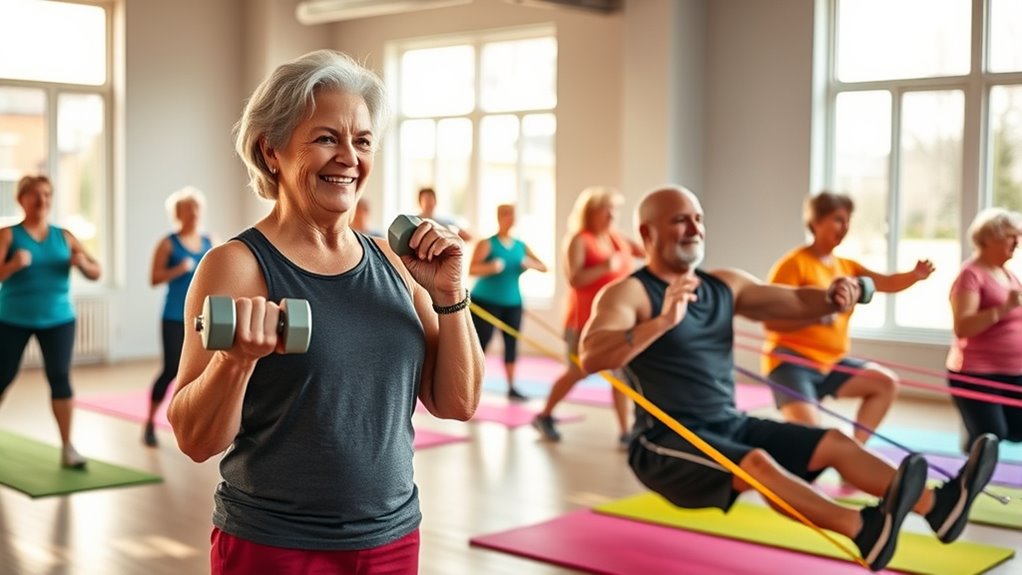
Strength training is essential for you as you age, helping maintain muscle mass that naturally declines over time.
By building strength, you can greatly reduce your risk of falls and fractures, enhancing your overall stability.
Incorporating resistance exercises into your routine can make daily activities easier and keep you independent longer.
Muscle Mass Maintenance
Maintaining muscle mass becomes increasingly important as you age, especially since the natural decline in muscle begins around age 30 and accelerates after age 60.
To guarantee your physical functionality and overall well-being, incorporate resistance training into your routine.
Consider the benefits of strengthening your muscles:
- Boost your muscle strength by 20-30% in just 8-12 weeks.
- Improve your balance and coordination, enhancing mobility.
- Reduce the risk of osteoporosis and fractures, keeping you active longer.
Engaging in regular exercise, particularly strength training, isn’t just about aesthetics; it’s about empowering yourself as an older adult to live a healthier, more independent life.
Prioritize your muscle mass today for a better tomorrow!
Fall Risk Reduction
As you focus on maintaining muscle mass, it’s equally important to contemplate how strength training plays a pivotal role in reducing your risk of falls.
For seniors, improved muscle strength and balance are critical in preventing falls. Regular strength training can lower your fall risk by about 23%, addressing a significant concern.
Exercises like wall push-ups and chair squats enhance your functional strength, making daily activities safer and easier. The CDC recommends engaging in muscle-strengthening activities at least two days a week to maintain independence and prevent injuries.
Not only does strength training combat muscle loss associated with aging, but it also boosts bone density, essential for preventing fractures if a fall does occur.
Balance and Stability Exercises
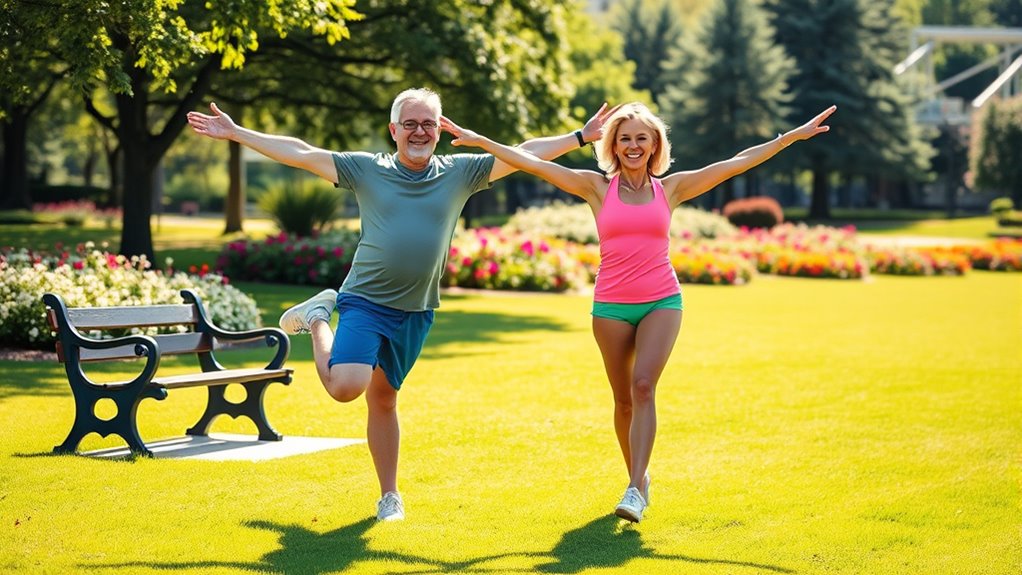
Balance and stability exercises are essential for seniors aiming to prevent falls and enhance their mobility. By incorporating these activities into your routine, you can greatly improve your independence and confidence.
Consider this:
- Balance exercises, like tai chi and single-leg stands, can reduce fall risk by up to 23%.
- Weight-shifting exercises strengthen your stability and coordination, making daily activities easier.
- Practicing standing on one leg for 10-30 seconds daily can bolster the muscles responsible for balance.
Engaging in structured balance training, such as community fitness classes, promotes improved mobility and helps you feel secure in your movements.
Aim for three sessions a week, and you’ll enjoy a greater quality of life while reducing your risk of injury from falls.
Mobility and Flexibility Workouts

Mobility and flexibility workouts play an essential role in your overall well-being, especially as you age. These exercises enhance your range of motion, making daily activities easier and reducing the risk of injury.
Regular stretching can improve blood circulation and joint health, contributing to your physical longevity. You can alleviate tension and discomfort in your muscles and joints by engaging in mobility exercises like neck stretches and ankle circles.
Incorporating flexibility training, such as yoga or Pilates, helps you achieve better posture and balance, which reduces the likelihood of falls.
Consistency is key; performing these exercises several times a week leads to lasting improvements in your physical function and independence.
Start today, and you’ll feel the benefits in no time!
Low-Impact Cardio Options

Low-impact cardio options can be a fantastic way for seniors to stay active while minimizing stress on their joints. Incorporating these exercises into your routine can greatly improve your health and well-being.
Low-impact cardio is an excellent way for seniors to stay active and enhance their overall well-being.
Aim for at least 150 minutes weekly for impactful benefits. Consider these enjoyable options:
- Water aerobics: Experience a full-body workout with reduced joint strain.
- Walking: Aim for 10,000 steps daily to considerably lower your mortality risk.
- Group classes: Engage in social activities like dance or gentle cycling to boost motivation.
These low-impact cardio options help enhance cardiovascular health, promote weight management, and improve endurance, making it easier to stay active and enjoy life to the fullest.
Fun and Engaging Group Activities
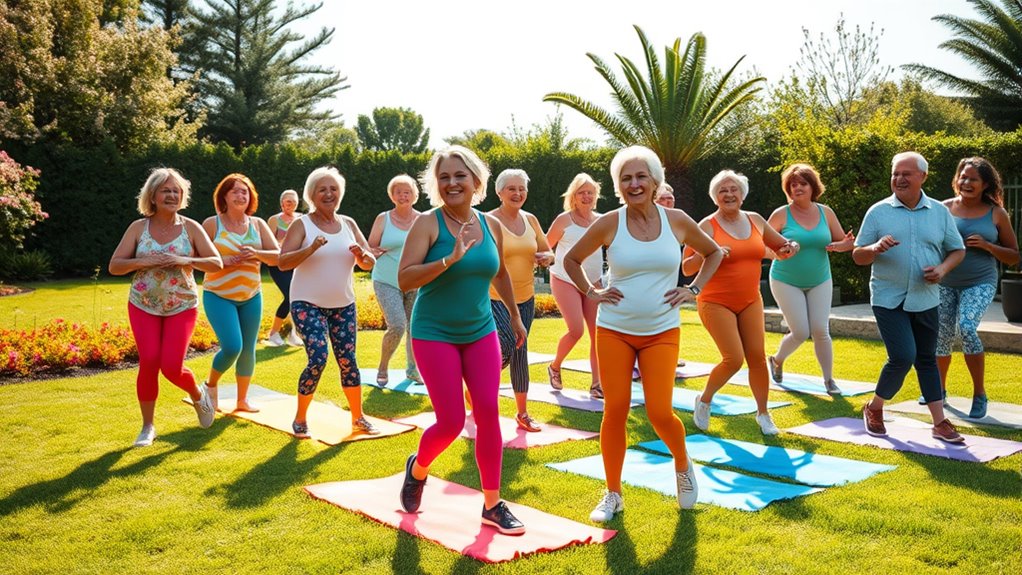
Joining social exercise classes or community sports events can make your fitness routine much more enjoyable.
You’ll not only stay active but also connect with others who share your interests.
These group activities can boost your motivation and help you stick to your exercise goals while having fun.
Social Exercise Classes
Social exercise classes offer a vibrant way for seniors to stay active while building connections.
These engaging group fitness classes, like water aerobics and tai chi, are designed specifically for older adults, ensuring safety and tailored activities.
Here’s what you can gain from participating:
- Enhanced social interaction, leading to new friendships and a sense of belonging
- Improved mental health, with reduced anxiety and depression symptoms
- Increased motivation to stick with regular physical activity
Joining social exercise classes not only boosts your fitness levels but also enriches your overall quality of life.
You’ll find that the camaraderie and support from fellow participants make every workout enjoyable, motivating you to stay committed to your health journey.
Community Sports Events
Community sports events provide an exciting opportunity for seniors to engage in fun activities while staying active. From walking clubs to tennis leagues and pickleball tournaments, these events encourage physical activity in a supportive environment.
By joining organized sports, you can improve your strength and enhance balance, which greatly reduces the risk of falls. Local community centers and senior organizations often host events tailored for older adults, ensuring you’ll find activities that suit your fitness level.
Plus, participating fosters motivation and commitment to regular exercise while building friendships and camaraderie with others. Embracing these community sports events not only boosts your physical health but also promotes mental well-being, keeping you connected and engaged in later life.
Getting Started With an Exercise Routine
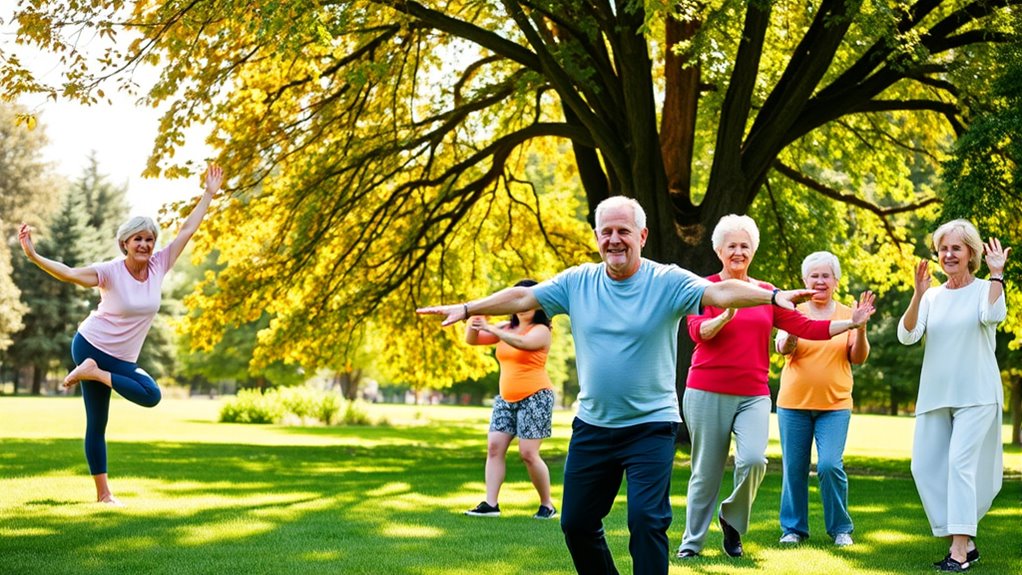
Before starting an exercise routine, it’s essential to consult with your healthcare provider to guarantee you’re choosing activities that align with your health conditions and fitness levels.
Once you’re cleared, aim for at least 150 minutes of moderate-intensity aerobic activity each week. You can break this down into manageable sessions, making it easier to stick to your exercise regimen.
Consider these tips to get started:
- Choose low-impact activities like walking or swimming to protect your joints.
- Incorporate exercises that strengthen muscles and improve balance.
- Mix in flexibility and cardiovascular activities for overall well-being.
Resources for Senior Fitness and Support
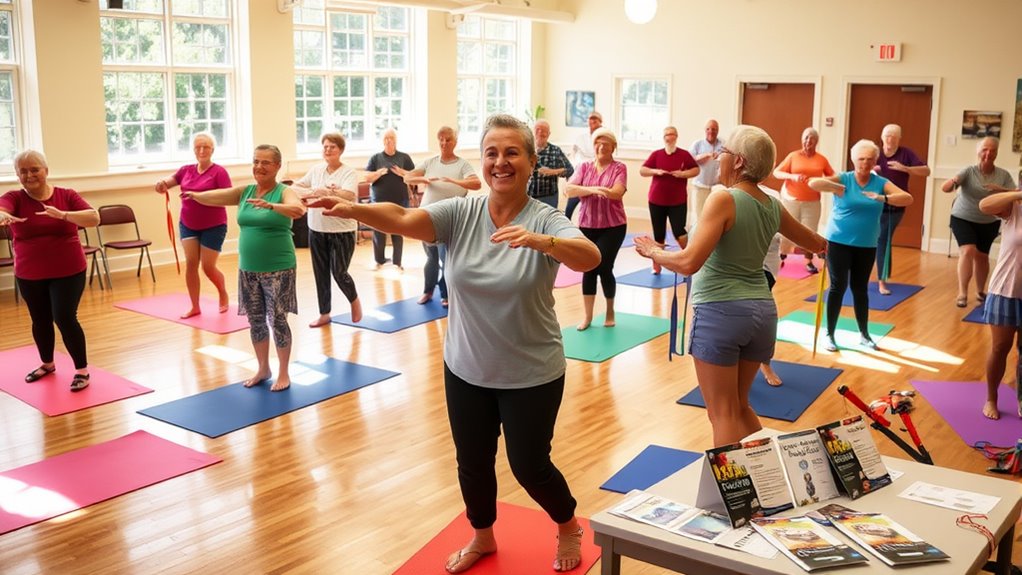
Finding the right resources can noticeably enhance your exercise journey.
Programs like SilverSneakers offer a wealth of free online fitness resources, including hundreds of On-Demand videos and live classes tailored specifically for older adults. Many community centers and gyms provide fitness classes designed for seniors, promoting social interaction and guaranteeing safety.
SilverSneakers offers free online fitness resources and specialized classes for seniors, ensuring safety and social engagement.
If you prefer personalized guidance, consider personal training sessions, which help you master proper form and safely challenge your limits. You’ll find a variety of enjoyable options, such as chair yoga, low-impact aerobics, and water aerobics, suitable for different fitness levels.
Before starting any exercise program, consult with your healthcare provider to confirm your activities align with your individual health needs.
Frequently Asked Questions
What Is the Number One Exercise for Seniors?
The number one exercise for seniors is walking. It’s low-impact, easy to fit into your daily routine, and can greatly enhance your overall health.
By walking just 150 minutes a week, you can improve your cardiovascular fitness, strengthen your bones, and boost your mental well-being. Plus, you can start at your own pace and gradually increase your distance.
Walking also offers a great chance to socialize—consider joining a walking group to stay motivated!
What Is the Number 1 Exercise to Increase Balance in Seniors?
The number one exercise to increase balance in seniors is tai chi. You’ll find that its slow, controlled movements and focus on weight shifting can greatly reduce your risk of falls.
It’s not just about tai chi, though—practicing single-leg stands and heel-to-toe walking can also enhance your stability.
Aim to incorporate these balance exercises into your routine 2-3 times a week, and you’ll feel more confident and independent in your daily activities.
What Is the 5 5 5 30 Exercise?
Imagine turning into a fitness superhero with just 15 minutes a day!
The 5 5 5 30 exercise routine is your secret weapon. You’ll tackle five minutes of cardio, five minutes of strength training, and five minutes of flexibility or balance exercises, separated by 30-second rests.
This structured plan fits right into your day, boosting your muscle strength, heart health, and balance, all while keeping things fun and manageable.
Give it a try!
Which Type of Exercise Is Most Strongly Recommended for Older Adults?
The most strongly recommended type of exercise for older adults is a combination of aerobic, strength, balance, and flexibility activities.
You should aim for at least 150 minutes of moderate-intensity aerobic exercise weekly, like walking or cycling.
Incorporate strengthening exercises to maintain muscle mass, and don’t forget balance exercises to prevent falls.
Adding flexibility routines, such as gentle stretching or yoga, enhances your overall mobility and keeps you feeling great as you age.
Conclusion
To sum up, embracing exercise can truly transform your routine and overall health as a senior. Research shows that staying active not only boosts your physical strength but also enhances your mental well-being. Don’t let age hold you back; instead, explore various exercises that suit your needs. By engaging in strength training, balance exercises, and fun group activities, you can enjoy a vibrant and fulfilling lifestyle. So, get moving—your body and mind will thank you!
